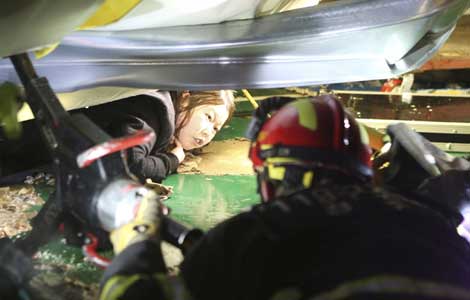Spirit of adventure lives on in Antarctic
Updated: 2014-02-19 01:44
By Zhang Lei and Dong Fangyu in Beijing (China Daily)
|
||||||||
 |
|
China’s fourth Antarctic research base, Taishan Station, can be used for scientific observations, accommodation, power generation, storage, maintenance of machinery, communications and as an emergency shelter. It also has oil storage installations and equipment to support a 400-metric-ton inland vehicle fleet. |
When Ernest Shackleton failed in his attempt to reach the South Pole 103 years ago, the British adventurer bemoaned what he saw as growing reluctance to explore the world.
However, a century after his doomed expedition, journeys into uncharted territory are still very much in vogue.
Antarctica is now home to more than 40 permanently manned international research stations, and 50 countries have signed the Antarctic Treaty, which ensures the status of the continent — the only one in the world without an indigenous human population — as a scientific preserve.

The opening on Feb 8 of Taishan, China's fourth Antarctic research station, is a further testament to the spirit of adventure.
The 1,000-square-meter station, named after one of China's most famous mountains, is located between two existing stations, Zhongshan and Kunlun, at an altitude of 2,621 meters and with an annual average temperature of -36.6 C. After Kunlun, Tai-shan is China's second inland expedition station in Antarctica, but will serve as a summer station because the facility can only be used from November to March.
Shaped like a giant Chinese lantern, the station is being threatened by continuous snowstorms, which show no signs of dying down, and have resulted in the 20-person crew retreating to Zhongshan Station on the coast, a journey of approximately 30 days.
Qu Tanzhou, director of the Chinese Arctic and Antarctic Administration, said Taishan Station is a critical step toward China expanding its ambitious Antarctic research program.
"Previously, when our team traveled from Zhongshan to Kunlun, we had to transport huge quantities of daily necessities because there is no midway supply point, and if severe weather occurs, we have nowhere to stay," he said.

 Spirit of adventure lives on in Antarctic
Spirit of adventure lives on in Antarctic
 Prince Charles dances in traditional Saudi dress
Prince Charles dances in traditional Saudi dress
 Maglev trains speeding toward greener future
Maglev trains speeding toward greener future
 Building collapse at Korean resort kills 10
Building collapse at Korean resort kills 10
 The big ballet stage
The big ballet stage
 17 more cement plants biting the dust
17 more cement plants biting the dust
 World's largest freshwater lake frozen
World's largest freshwater lake frozen
 American photographer wins World Press Photo 2013
American photographer wins World Press Photo 2013
Most Viewed
Editor's Picks

|

|

|

|

|

|
Today's Top News
Reforms to put safety first for low-level flights
PLA soldiers bigger, need new gear
China's aviation school banks on global ties
Green timber preferred overseas but not locally
NHK head regrets history words
Police to root out organizers of prostitution
Li to officials: Move ahead with improvements
'Equal' talks open to Taipei
US Weekly

|

|





